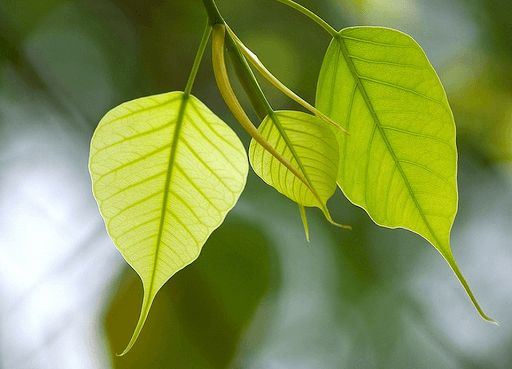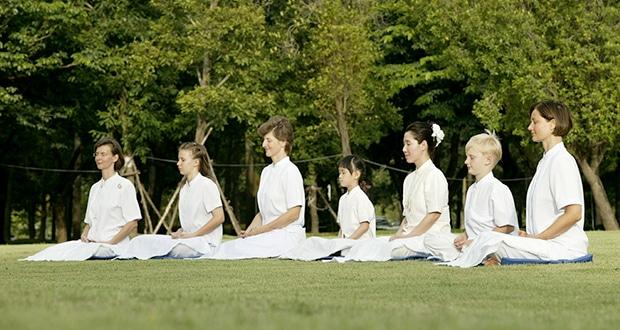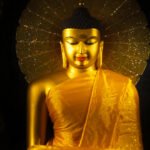Most of us observe the eight precepts on poya days, mainly on the full moon poya days. We get dressed in white cloths, go to the temple in the morning, sit on a lower chair or on a mat, listen to the Dhamma preached by the bhikkhu, have lunch before 12 mid and come home around 4 or 5 pm. Some would protect the observed eight precepts until next morning, while others would get back to the five precepts in the evening of the poya day. If we did this without any knowledge of the why we, the disciples of the Buddha, do this, then it becomes a ritual, something we blindly follow. But there are no rituals in the noble teachings of the Buddha. Everything that the supreme Buddha has set forth has a meaning, has a purpose and leads to the understanding of the noble truths.
To learn the purpose of observing the eight precepts, known as ‘Uposatha seela’, and how to spend that day meaningfully, we need to look into the discourses of the supreme Buddha that explains Uposatha seela. Visakhuposatha sutta in Anguttara nikaya is a discourse on Uposatha said to Visakha, who was a stream entreat – Sotapanna – disciple of the supreme Buddha. In this discourse, the supreme Buddha first explains that there are 3 kinds of Uposatha;
• Gopalaka Uposatha
• Nighanta Uposatha
• Arya Uposatha
In Gopalaka Uposatha, one thinks about food, like the shepherd who takes his sheep or cows to feeding grounds thinks to which field he can take his herd tomorrow.
In Nighanta Uposatha, one gets undressed and says “I have no attachment to anything”. Then this person practices kindness towards beings living within a range of 100 miles from him. At the end of the day he wears his normal cloths and goes back to home to his loved ones.
Then the supreme Buddha explains what is Arya Uposatha? “Kathancha Visakhe ariyo uposatho? – Visakha what is ariya uposatha?” In Arya Uposatha, a person uses different methods, different schemes to cleanse his mind which clogs with defilements. There are two important facts in this statement. One is, our mind gets clogged with defilements and secondly, it can be cleansed. Here the supreme Buddha explains five different methods that can be used to cleanse one’s mind.
1. Buddhanussati – “Idha Visake ariya savako tathagatan anussarati”
Buddhanusati is meditating or contemplating on the great qualities of the supreme Buddha that is concentrated in to the stanza; “Ithipiso Bhagava arahan, samma-sambuddho…” This contemplation gives rise to elation, freshness to one’s mind. And that elation washes away the defilements in the mind. This act of cleansing one’s mind through Buddhanussati is explained in a simile: like a person cleansing his hair using water, soap and effort. Further, the supreme Buddha explains, “ariyo savako buddhoposathan upavasati, brahmuna saddin sanvasati”; when a person practices Buddhanussati, it is like living with the Brahma, because during that time his/her mind develops the qualities, abodes of a Brahma: loving-kindness, compassion, empathy, equanimity. Thus it is also called ‘Brahmuposatha’.
2. Dhammanussati – the second method of cleansing one’s mind is contemplating on the qualities of the noble Dhamma, said in the stanza “swakkhato bhagavatha dhammo…” And that is compared to cleaning one’s body with water, soap and effort. When a person practices Dhammanussati, elation, grows in his/her mind and that euphoria chases the defilements away. It is called ‘Dhammuposatha’. He is being happy by thinking of this noble Dhamma, and that helps him cleanse his mind.
3. Sanghanussati – next scheme used by the ariya savaka – disciple of the Buddha, to cleanse his mind is contemplating on the qualities of the noble sangha as said in “Supatipanno bhagavathoo savaka sangho…” When Sanghanussati is developed in one’s mind, freshness develops and that freshness rids defilements in the mind. This was compared to washing a dirty cloth with water soap and effort. This is called ‘Sanghuposatha’.
4. Seelanussati – the forth method of cleansing one’s mind according to Arya Uposatha is, contemplating on one’s own virtues. Here, a person thinks whether he/she was able to protect all precepts without breaking them. If a person has protected some precepts and some are broken then his seela-virtues are not perfect. The supreme Buddha said to think about your virtues in the following manner to make them prefect.
• Whether you are being virtuous in order to gain praise from others.
• Will a wise person approve your virtues?
• Whether you observe precepts or being virtuous to gain worldly comforts or to be free from samsara.
• Whether your precepts help calm your mind.
If one is able to achieve prefect virtues, then that give rise to elation. And that elation will expel the defilements from one’s mind. It compared to cleaning a mirror. This method of cleansing and spending the poya day is called ‘Seeluposatha’.
5. Devatanussati – The final method that can be used to cleanse one’s mind is Devatanussati. Here, one thinks thus, ‘the devas, gods in Thusitha world (up to Paranimmitha vasavatti and Brahma worlds), were once humans. And they had faith in the supreme Buddha, they were virtuous, they had Dhamma knowledge, they were generous and they were wise in the noble Dhamma. I too have these qualities – these sekha bala.’ Like that, the person compares his/her sekha bala to the sekha bala of the gods. This method too gives rise to elation that exhausts defilements in the mind. The method is compared to cleaning gold and called ‘Devata-uposatha’.
This is how a disciple of the Buddha is supposed to spend his/her Uposatha day. Cleansing his mind using different methods. Next in this discourse the supreme Buddha explains that the eight precepts are observed in order to follow the great lives of the Arahaths. He observes or undertakes the first precept thus;
“For all their lives the Arahants dwell having abandoned killing living beings, refrain from killing living beings, they have laid down their staffs, laid down their weapons, they are sympathetic, compassionate for all living beings; so today I dwell, for this night and day, having abandoned killing living beings, refraining from killing living beings, I am one who has laid down my staff, laid down my weapon, I am sympathetic, compassionate for all living beings. By this practice, following after the arahants, I enter the Uposatha”.
Likewise, the disciple of the Buddha observes all eight precepts in order to follow the life of an Arahath.
Finally, the advantage, the grandeur of the Arya Uposatha is expounded. Here, the supreme Buddha explains that Arya Uposatha is worth more than being the king of all the great countries in the world. And one who undertakes Arya Uposatha, as explained above will be born in the heavenly worlds after death. If you think about this practice of cleansing the mind and this way of observing the precepts, then you can understand the possibility of this result.
The supreme Buddha expounded the noble Dhamma in such clear manner, that as disciples all we need to do is learn and follow it. Now that you learnt about the Arya Uposatha, try to remember and practice this on poya days.
By Prajapathi Jayawardene














Recent Comments